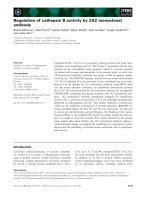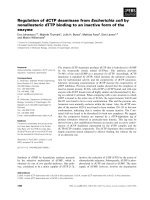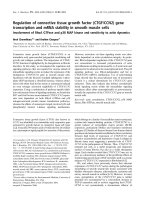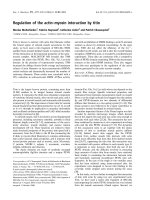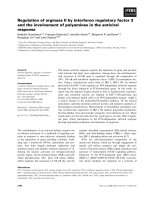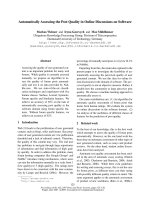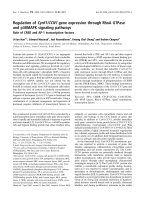Báo cáo khoa học: "Regulation of the erm(C) Gene in Staphylococci from Reservoir with Different Usage of Macrolides" docx
Bạn đang xem bản rút gọn của tài liệu. Xem và tải ngay bản đầy đủ của tài liệu tại đây (64.31 KB, 4 trang )
Acta vet. scand. vol. 46 no. 3, 2005
A high prevalence of macrolide resistant iso-
lates has been found among staphylococci iso-
lated from animals (4). The erm(C) gene is the
most common gene encoding macrolide resis-
tance in staphylococci (8). It is well known that
expression of the erm(C) gene is normally reg-
ulated by formation of hairpin structures up-
stream for the erm(C) gene (5,9) rendering the
start codon of erm(C) gene non-accessible.
Only 14- and 15-membered macrolides like
erythromycin can induce expression of the gene
and induce resistance while 16-membered
macrolides cannot activate expression of erm
(C) (7). If deletions from 16 to 116 bp occur in
the regulatory area, expression of the erm(C)
gene becomes constitutive (10). Constitutive
expressed erm(C) genes give resistance not
only to 14-and 15-membered macrolides, like
erythromycin, but also to 16-membered macro-
lides like spiramycin, tylosin and streptogramin
B (6). Deletions are believed to be the result of
high concentration of non-inducible macrolides
like tylosin in the environment, selecting for
constitutive expression of the macrolide resis-
tance. In the presence of macrolides, like ty-
losin, this could give staphylococci with consti-
tutive expressed erm(C) a selective advantage
not only to sensitive staphylococci but also to
staphylococci containing regulated erm(C)
genes. In this article we have investigated the
ratio of regulated and constitutive expressed
erm(C) genes in human and animal reservoirs
(cattle and pigs) with differences in uses of the
16-membered macrolide tylosin.
Large amounts of the macrolide tylosin have
been used for pig production in Denmark for
growth promotion and therapy (1). In 1996
68,350 kg of tylosin was used for growth pro-
motion and 1,350 kg for therapy. No macrolides
have been used for growth promotion for cattle
but spiramycin and tylosin have been used ther-
apeutically for treatment of mastitis (3). A total
of 644 kg macrolides, primarily tylosin, was
used for cattle in 1996 in Denmark. Local vari-
ations in treatment strategies exist depending
on the choice of the veterinarian but due to the
used strain collection this effect will be mini-
mal. At the same time 5,934 kg of penicillin
was used (Erik Jacobsen, personal communica-
tion). The usage of macrolides for treatment of
infections in human in general practice consti-
tutes approximately 20-25 percent of the total
usage of antibiotics in humans. However, in hu-
man medicine 16-membered macrolides are not
used. The macrolides used in human medicine
in Denmark are primarily erythromycin (14-
membered) and azithromycin (2).
A total of 185 macrolide resistant staphylococci
Acta vet. scand. 2005, 46, 163-166.
Regulation of the erm(C) Gene in Staphylococci from
Reservoir with Different Usage of Macrolides
By Lars B. Jensen and Frank. M. Aarestrup
Danish Institute for Food and Veterinary Research, Bülowsvej 27, DK-1790 Copenhagen V, Denmark.
Brief Communication
were tested, twenty-nine staphylococci from
cattle (8 Staphylococcus aureus and 21 coagu-
lase negative staphylococci (CNS)), 111 Sta-
phylococcus hyicus isolates of porcine origin
and 45 S. aureus from non-hospitalized humans
(4). All animal isolates were obtained from the
DANMAP surveillance program with one iso-
late per herd hereby representing a broad spec-
trum of farms in Denmark. Human isolates
were obtained from individuals of both sex and
from different age groups. All human, bovine
and 96 porcine isolates were collected from
1995 to 1998. The remaining 15 porcine iso-
lates were collected in 2001, two years after the
164 L. B. Jensen and F. M. Aarestrup
Acta vet. scand. vol. 46 no. 3, 2005
Strain Origin SD-1 MetGlyIlePheSerIlePheVal
10 20 30 40 49
46823 human 1 ACTAATTTTATAAGGAGG
AAAAAATATGGGCATTTTTAGTATTTTTGTA
9731065-8 cattle 1 ACTAATTTTATAAGGAGGAAAAAATATGGGCATTTTTAGTATTTTTGTA
9731065-7 cattle 1 ACTAATTTTATAAGGAGGAAAAAATATGGGCATTTTTAGTATTTTTGTA
9730363-2 porcine 1 ACTAATTTTATAAGGAGGAAAAAATATGGGCATTTTTAGTATTTTTGTA
39961 human 1 ACTAATTTTATAAGGAGGAAAAAATA
39996 human 1 ACTAATTTTATAAGGAGGAAAAAATA
9730363-6 porcine 1 ACTAATTTTATAAGGAGGAAAAAATA
43288 human 1 ACTAATTTTATAAGGAGGAAAAAATA
9730249-1 cattle 1 ACTAATTTTATAAGGAGGAAAAAA
9730363-4 porcine 1 ACTAATTTTATAAGGAGGAAAAAA
9730363-5 porcine 1 ACTAATTTTATAAGGAGGAAAAAA
9730363-7 porcine 1 ACTAATTTTATAAGGAGGAAAAAA
9730517-1 cattle 1 ACTAATTTTATAAGGAGGAAAAAA
9731066-2 cattle 1 ACTAATTTTATAAGGAGGAAAAAA
IleSerThrValHisTyrGlnProAsnLysLysEND Hair pin II
60 70 80 90 100
46823 human 50 ATCAGCACAGTTCATTATCAACCAAACAAAAAATAAGTGGTTATAATGAAT
9731065-8 cattle 50 ATCAGCACAGTTCATTATCAACCAAACAAAAAATAAGTGGTTATAATGAAT
9731065-7 cattle 50 ATCAGCACAGTTCATTATCAACCAAACAAAAAATAAGTGGTTATAATGAAT
9730363-2 porcine 50 ATCAGCACAGTTCATTATCAACCAAACAAAAAATAAGTGGTTATAATGAAT
39961 human 50
39996 human 50
9730363-6 poricne 50
43288 human 50
9730249-1 cattle 50
9730363-4 porcine 50
9730363-5 porcine 50
9730363-7 porcine 50
9730517-1 cattle 50
9731066-2 cattle 50
Hair pin III SD-2 Met
110 120 130 140 150
46823 human 101 CGTTAATAAGCAAAATTCATTATAACCA
AATTAAAGAGGGTTATAATGAA
9731065-8 cattle 101 CGTTAATAAGCAAAATTCATTATAACCAAATTAAAGAGGGTTATAATGAA
9731065-7 cattle 101 CGTTAATAAGCAAAATTCATTATAACCAAATTAAAGAGGGTTATAATGAA
9730363-2 porcine 101 CGTTAATAAGCAAA TTAAAGAGGGTTATAATGAA
39961 human 101 AAGAGGGTTATAATGAA
39996 human 101 AAGAGGGTTATAATGAA
9730363-6 porcine 101 AAGAGGGTTATAATGAA
43288 human 101 GAGGGTTATAATGAA
9730249-1 cattle 101 GAGGGTTATAATGAA
9730363-4 porcine 101 GAGGGTTATAATGAA
9730363-5 porcine 101 GAGGGTTATAATGAA
9730363-7 porcine 101 GAGGGTTATAATGAA
9730517-1 porcine 101 GAGGGTTATAATGAA
9731066-2 porcine 101 GAGGGTTATAATGAA
Figure 1. Regulation of expression of the erm(C) gene. Deletions in the regulatory region of erm(C) in staphy-
lococci from animal and human origin were identified by sequencing PCR amplicons obtained using primers
RegermC-1 (5'-TAAACCGTGTGCTCTACGA C-3') and RegermC-2 (5'-CCTTTTCCTGAGCCGATTTC-3').
Origins of strains are indicated as well as Shine-Delgano (SD-1 and SD-2) sequences, sequence of the leader
peptide (by amino acid translation) and start of erm(C) (Met…). Underlined bases indicate position of hairpin II
and III.
discontinued usage of growth promoters in
Denmark.
The presence of erm(C) was confirmed using
previous described primers (4). Among the an-
imal isolates from 1995-98, all except one
porcine isolate contained the erm(C) gene
(Table 1). erm(C) was found in 23 (69%) of the
human isolates and 7 (47%) of the porcine iso-
lates from 2001. PCR for erm(A) and erm(B)
was performed for porcine isolates from 2001.
No positive amplicons were obtained (data not
shown). A set of PCR primers (RegermC-1:
5'-TAAACCGTGTGCTCTACGAC-3' and Re-
germC-2: 5'-CCTTTTCCTGAGCCGATTTC-
3') was constructed spanning the regulatory re-
gion upstream the erm(C) gene and PCR
amplification was performed. Fourteen ampli-
cons from selected strains from the three differ-
ent reservoirs were sequenced. Results are pre-
sented in Figure 1.
Deletion of 16 bp, 107 bp, 109 bp and 111 bp
was found in the regulatory region of erm(C).
Based on the obtained sequences, the size of the
PCR amplicons could be used to determine
whether an erm(C) gene was expressed consti-
tutive or regulated. Results on regulation of the
erm(C) gene in the three reservoirs are pre-
sented in Table 1.
The differences in occurrence of regulated
erm(C) between isolates from the different
reservoirs were statistically significant (chi-
square test). Significant difference could be
demonstrated between S. hyicus from pig from
1995-98 and 2001 (p=0.034) and between
staphylococcal isolates from pigs and cattle
(p=0.013), isolates from cattle and humans
(p<0.001) and isolates from humans and pigs
(p<0.001).
In a reservoir with high usage of tylosin consti-
tutive expressed erm(C) genes were dominant
(91% in porcine isolates from 1995-98). In a
reservoir with moderate usage of tylosin consti-
tutive expressed genes was still most prevalent
(69% in cattle and 57% in pigs from 2001)
while in a reservoir with no usage of tylosin
regulated erm(C) genes was most prevalent
(81% in human isolates). When comparing
porcine erm(C) positive S. hyicus isolates from
1995-98 with isolates from 2001 a change in
the ratio could be observed between constitu-
tive and regulated genes. This change to a
higher prevalence of regulated erm(C) genes
could reflect the changes in usage of tylosin in-
troduced by the discontinuous usage of growth
promotion in 1998 in Denmark. Results pre-
sented here indicate that the ratio of constitutive
Regulation of the erm(C) gene in staphylococci with different usage of macrolides 165
Acta vet. scand. vol. 46 no. 3, 2005
Table 1. Identification of presence and regulation of the erm(C) gene was done using PCR. Classification of
genes as regulated or constitutive was based on size of the obtained amplicon. Consumption of antimicrobial
agents in the three reservoirs is indicated.
Presence and regulation of erm(C)
among staphylococci of human and animal origin
Origin Human Cattle Pigs
S. aureus staphylococci S. hyicus
Year 1995-1998 1995-1998 1995-1998 2001
Usage low moderate high low
n = 45 29 96 15
erm(C) positive* 69 100 99 47
regulated 81 31 9 43
constitutive 19 69 91 57
* All numbers are given in percentage
to regulated erm(C) genes could be related to
the amount of tylosin used in the different
reservoirs. Statistically significant differences
in occurrence of constitutive and regulated
erm(C) genes were demonstrated for reservoirs
with different usage of tylosin. This indicates
that not only have the usage of tylosin selected
for macrolide resistant staphylococci (2) but
regulation of expression of the erm(C) gene has
also been changed. Since regulated erm(C) do
not give resistance to tylosin and only very lim-
ited amount of spiramycin and tylosin has been
used for human therapy, the higher prevalence
of constitutive expressed resistance genes in an-
imal isolates compared to human isolates could
be associated to the usage of tylosin as growth
promoter and prevalence of constitutive ex-
pressed erm(C) in the human reservoir could
indicate an animal origin of the resistance.
References
1. Aarestrup FM, Bager F, Jensen NE, Madsen M,
Meyling A, Wegener HC: Surveillance of antimi-
crobial resistance in bacteria isolated from food
animals to antimicrobial growth promoters and
related therapeutic agents in Denmark. AP-
MIS1998, 106, 606-622.
2. DANMAP 2003: Use of antimicrobial agents and
occurrence of antimicrobial resistance in bacteria
from food animals, food and humans in Den-
mark. ISSN 1600-2032, 2004.
3. De Oliveira AP, Watts JL, Salmon SA, Aarestrup
FM: Antimicrobial susceptibility of Staphy-
lococcus aureus isolated from bovine mastitis in
Europe and the United States. J.Dairy Sci. 2000,
83, 855-862.
4. Jensen LB, Frimodt-Moller N, Aarestrup FM:
Presence of erm gene classes in Gram-positive
bacteria of animal and human origin in Denmark.
FEMS Microbiol.Lett. 1999, 170, 151-158.
5. Leclercq R, Courvalin P: Bacterial resistance to
macrolide, lincosamide, and streptogramin an-
tibiotics by target modification. Antimicrob.
Agents Chemother. 1991, 35, 1267-1272.
6. Lodder, G, Schwarz S, Gregory P, Dyke K: Tan-
dem duplication in ermC translational attenuator
of the macrolide- lincosamide-streptogramin B
resistance plasmid pSES6 from Staphylococcus
equorum. Antimicrob.Agents Chemother. 1996,
40, 215-217.
7. Lodder G, Werckenthin C, Schwarz S, Dyke K:
Molecular analysis of naturally occuring ermC-
encoding plasmids in staphylococci isolated from
animals with and without previous contact with
macrolide/lincosamide antibiotics. FEMS Im-
munol.Med.Microbiol. 1997, 18, 7-15.
8. Roberts MC, Sutcliffe J, Courvalin P, Jensen LB,
Rood J, Seppala H: Nomenclature for macrolide
and macrolide-lincosamide-streptogramin B re-
sistance determinants. Antimicrob. Agents
Chemother. 1999, 43, 2823-2830.
9. Weisblum B: Insights into erythromycin action
from studies of its activity as inducer of resis-
tance. Antimicrob.Agents Chemother. 1995, 39,
797-805.
10. Werckenthin C, Schwarz S, Westh H: Structural
alterations in the translational attenuator of con-
stitutively expressed ermC genes. Antimicrob.
Agents Chemother. 1999, 43, 1681-1685.
166 L. B. Jensen and F. M. Aarestrup
Acta vet. scand. vol. 46 no. 3, 2005
(Received May 19, 2004; accepted May 18, 2005).
Reprints may be obtained from: Lars B. Jensen, Danish Institute for Food and Veterinary Research, Bülowsvej
27, DK-1790 Copenhagen V, Denmark. E-mail: , tel: (+45) 72 34 60 00, fax: (+45) 72 34 60 01.



